Fact Sheet FS338
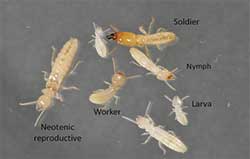
Figure 1: Termite castes/developmental stages in a subterranean termite colony. The king and queen are not shown.
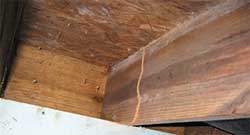
Figure 2: A termite mud tube on a beam.
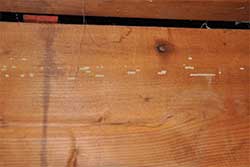
Figure 3: Termite mud tubes in woods.
Termites are the most destructive insects to homes. In the U.S., termite control costs alone exceeds $1.5 billion each year. Most people are not aware of termites until significant damage to the structure has occurred. It is therefore very important to understand the basic biology, prevention, and control of termites.
Termite Species
All naturally occurring termites in the northeastern U.S. belong to a group called subterranean termites (genus Reticulitermes) (Figure 1). The common name comes from their habit of nesting in the soil. Their nests are rarely found above ground. Subterranean termites build mud tubes and bring soil to the wood where they feed (Figure 2 and 3). In the southern U.S. and western U.S., drywood and dampwood termite species are also found. They nest in wood above ground. Occasionally, drywood termites may be transported along with infested furniture or timber to other parts of the country. Drywood termites do not bring soil to the wood, and they produce pellets as they feed. These termites usually do not cause damage to structures outside their natural distribution areas.
Termites are social insects with various castes. Most of the members are white in color. Only the king, the queen, and swarmers (also called alates) are darkly pigmented. Soldiers' heads are reddish. Most people encounter termites during spring when termite swarmers (Figure 2) leave their natal nests. Termite swarmers may be confused with ant swarmers but can be distinguished by the following:
| Points of Difference | Termite Swarmers | Ant Swarmers |
|---|---|---|
| Size of wings | Hind wings are approximately the same size as the forewings. | Hind wings are much smaller than the forewings. |
| Color of wings | Dusky | Clear |
| Veins of wings | Weak | Very distinct |
| Shape of body | The abdomen is joined snugly to the thorax, without a node or waist. | The abdomen is distinctly separated from the thorax by a very small node or thin waist. |
| Antennae | Beadlike | Elbow-shaped |
Termite Biology
Each subterranean termite colony contains reproductives (a king, a queen, and some neotenic reproductives), larvae, nymphs, workers, and soldiers (Figure 1). The neotenic reproductives are non-alates, and they produce fewer eggs than the queen. The majority of colony members are workers. They look for food, feed the other members of the colony, and maintain the nest and foraging tunnels. Soldiers have rectangular brownish heads and long mandibles. They typically account for 1–2% of the members. Nymphs develop into alates or neotenic reproductives. A colony may have hundreds or thousands of neotenic reproductives. The neotenic reproductives play an important role in the growth and expansion of colonies. Thus, killing the queen will not cause the colony to die. A mature colony has 60,000 to 1 million individuals.
Subterranean termites naturally occur in forests and urban environments where cellulose materials (such as stumps, mulch, and dead trees) exist. Most of the houses in the U.S. contain wood materials. When the wood materials become moist or contact the soil, termites will find their way into the wood. Workers constantly forage for food. Their only food is cellulose material such as wood and paper. Under ideal conditions, a termite colony of 60,000 would consume about 5 grams, or 1/5 ounce of wood each day. A subterranean termite colony may cover 260 ft linear distance.
A new subterranean termite colony can be formed in two ways:
- a pair of swarmers (a male and a female alate) mate, drop wings, and build a nest;
- budding from an existing colony.
The swarming adults only appear once or twice from mature colonies every year. Hundreds or thousands of swarmers leave the nest during warm sunny days between April–June. This is when most homeowners first notice termites in their homes. After a brief flight, the swarmers soon drop their wings and form pairs. They then look for a moist, sheltered place to build a nest. It takes several years for the colony to mature and produce swarmers. As the colony grows, part of it may separate from the main colony and form a new colony. Neotenic reproductives head such budded colonies.
How to Conduct a Proper Termite Inspection?
It is not difficult for a layperson to inspect a home for termites when obvious signs are present (Figure 3 and 4). Unfortunately, mud tubes are often absent, making it very difficult to determine whether termites are present. It is even more difficult for a layperson to distinguish between old termite damage and new termite damage. For these reasons, homeowners are encouraged to consult with experienced professionals for a quality inspection. The following are the general procedures for conducting a termite inspection. First, obtain inspection tools. A flashlight and a probing tool (garden trowel, screw driver, or ice pick) are a must. Knee pads, a hard hat, a mirror, collection bottles for specimens, and a moisture meter will help with an inspection. An inspection should focus in areas where there is high moisture and wood or other cellulose materials: window sills, the bottom of door frames, the crawl space, the basement, and foundations immediately above ground, etc. Look for mud tubes and damaged wood. Tap the exposed wood with a probing tool. A hollow sound may reveal damage beneath the wood surface. Old houses may have mud tubes from previous infestations. Gently break a small section of the mud tubes to determine whether they are moist and whether termites are currently present. Active mud tubes can be distinguished from old mud tubes by a darker color, moist soil, and presence of live termites. Use a garden trowel to examine the mulch near the foundation. If termites are found in the mulch, the structure should be very thoroughly inspected, since termites can occur in the immediate vicinity. It is a good idea to inspect the house at least once a year in the summer to detect termite activity.
Prevention
It is usually much easier and cheaper to conduct preventive work than to treat an infestation. Thus, property owners should follow common sense rules to avoid expensive treatment and repair afterwards.
First, avoid wood-to-soil contact or use treated wood if wood has to be used in a moist area. Ideally, any wood in a structure should be at least 6 inches above the soil. Repaint any wood that is close to the ground every few years to prevent moisture intrusion. Do not bury any wood materials (stumps, branches, wood debris) when building a home. Do not place cellulose materials (such as firewood, mulch) immediately adjacent to a house. Using rocks or rubber mulch near the house will reduce the probability of termites remaining near the house. Cut down shrubs or large trees and remove stumps near the foundation to reduce the presence of roots and plant debris.
Second, reduce moisture and promptly repair leaks. The gutters and down spouts should be properly installed and maintained. Seal cracks and holes on exterior walls to prevent moisture getting inside the walls. Crawl spaces should be properly ventilated.
Third, use treated wood or steel in porches and other areas that are susceptible to termite attack.
Fourth, install stainless steel mesh or pesticide-impregnated sheeting for new construction. These technologies are currently not widely used in the U.S.
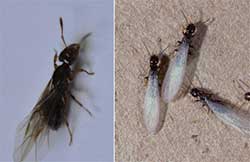
Figure 4: Comparison of an ant swarmer and termite swarmers.
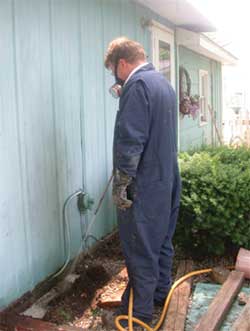
Figure 5: Applying liquid insecticide to a trench.
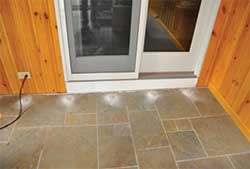
Figure 6: Holes in a slab for injecting insecticide. These will later be filled with mortar.
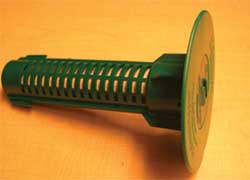
Figure 7: In-ground termite bait station.
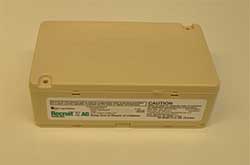
Figure 8: Aboveground termite bait station.
Control
Once termites are found in a home, treatment is necessary to kill them. There are two types of treatments commonly used: soil treatment and baiting. Proper treatment requires special training, equipment, and materials. Homeowners should look for licensed professionals to properly eliminate termite infestations.
A soil treatment requires digging a trench around the exterior perimeter of the house. A liquid insecticide is then applied to the trench to form a continuous barrier between the house and the soil outside of the house (Figure 5). In conjunction with the exterior treatment, the insecticide may be applied also locally inside homes in areas where termite activities are found. In areas covered by concrete or wood, small holes are drilled every 12 inches or as the label directs (Figure 6). Insecticides are then injected with a rod, and the holes are plugged or otherwise filled. Because termites nest in the soil and constantly travel back and forth between the soil and the wood, they come in contact with the treated soil. When properly treated, a colony may be eliminated within one or two months. The soil treatment can be effective for more than 5 years.
Commonly used liquid termiticides can be grouped into non-repellent and repellent termiticides. Non-repellent termiticides include fipronil, imidacloprid, and chlorfenapyr. These active ingredients are relatively slow-acting. Termites freely re-enter treated soil. They pick up enough dose of the material as they pass through the treated areas and transfer the chemical to their nestmates, causing the death of the whole colony. Commonly used repellent termiticides include permethrin, cypermethrin, fenvalerate, and bifenthrin. They belong to a chemical group called pyrethroids. Pyrethroids are highly repellent to termites and provide a barrier around the structure. However, pyrethroid treatments do not diminish termite populations in soil. Termites in the vicinity of the treatment would continue to forage freely. Thus, non-repellent termiticides are preferred materials used by professionals for treating structures that are already infested.
Baiting is another commonly used termite treatment method. In this method, plastic tubes are installed underground at approximately 10 ft. intervals encircling the house (Figure 7). Each tube contains wood and/or toxic bait. The bait tubes are examined regularly, from monthly to annually, depending on the type of bait tubes being used. Termites foraging around the house will eventually find the wood or bait. The bait is more palatable than the wood and contains a slow-acting material. Termite workers eat the bait and bring the material to the rest of the members of the colony. A colony will be killed over a few months once termites find the bait. Aboveground termite bait stations can be placed inside houses where termite activity is found (Figure 8). Each termite bait needs to be inspected periodically (quarterly to annually) to ensure enough bait remains, and that termites are eliminated. Commonly used active ingredients in baits are noviflumuron, hexaflumuron, and diflubenzuron.
In general, liquid treatment is often cheaper than bait treatment, depending upon the size of the structure to be treated. Liquid treatment provides immediate protection to the structure. Disadvantages are:
- The procedures are somewhat destructive (such as drilling holes into concrete surfaces, digging a trench).
- A large volume of insecticides is applied to the environment.
- Structures with a well, spring, or cistern nearby cannot be treated with liquid insecticides due to possible water contamination issues.
Bait treatment has little environmental impact because the bait is contained inside capped plastic tubes. After termites are eliminated, the bait can be removed and no pesticides remain on the property. The equipment needed for bait treatment is simple. The treatment causes little destruction to the property. Disadvantages of this method include:
- It may take several months or more for termites to find the stations.
- The lag time between monitoring and baiting extends the period to achieve termite control.
- The baits need to be inspected periodically and maintained.
- Homeowners, their children, or pets may dislodge the bait stations through gardening, playing, or mowing activities.
Do I Need Annual Termite Inspection Service?
Pest control companies often recommend annual inspection services after termite treatment to detect future termite activity. This is helpful to detect termite infestation early. Homes surrounded by large trees, old stumps, or beds of deep mulch are more likely to have new infestations over time. Alternatively, homeowners may use over-the-counter monitoring stations for monitoring termite activity. Strategically place the monitors in areas that favor termite survival such as in the mulch, besides a stump or wooden deck. Inspect the monitors a few times a year between April–November. Termite infestations in the northeastern U.S. almost always start from outside. Installing monitoring stations around homes is a good proactive method for detecting new termite activity.
Reference
Mention or display of a trademark, proprietary product, or firm in text or figures does not constitute an endorsement by Rutgers Cooperative Extension and does not imply approval to the exclusion of other suitable products or firms.
Photo credits: University of Georgia (Figure 4 right); Changlu Wang (Figures 1–3, 4 left, 5–8).
March 2019
Copyright © 2025 Rutgers, The State University of New Jersey. All rights reserved.
For more information: njaes.rutgers.edu.
Cooperating Agencies: Rutgers, The State University of New Jersey, U.S. Department of Agriculture, and Boards of County Commissioners. Rutgers Cooperative Extension, a unit of the Rutgers New Jersey Agricultural Experiment Station, is an equal opportunity program provider and employer.

